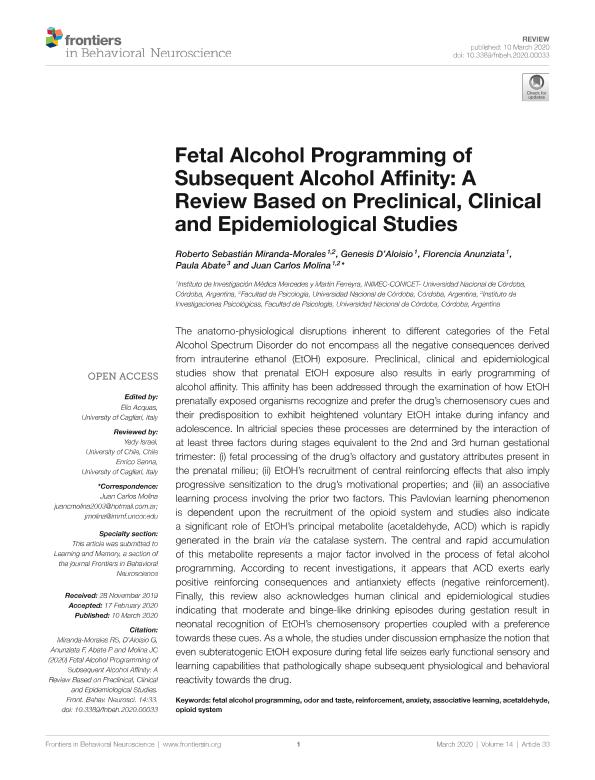Artículo
Fetal alcohol programming of subsequent alcohol affinity: A reviewb ased on preclinical, clinical and epidemiological studies
Miranda Morales, Roberto Sebastián ; D'aloisio, Génesis
; D'aloisio, Génesis ; Anunziata, Florencia
; Anunziata, Florencia ; Abate, Paula
; Abate, Paula ; Molina, Juan Carlos
; Molina, Juan Carlos
 ; D'aloisio, Génesis
; D'aloisio, Génesis ; Anunziata, Florencia
; Anunziata, Florencia ; Abate, Paula
; Abate, Paula ; Molina, Juan Carlos
; Molina, Juan Carlos
Fecha de publicación:
04/2020
Editorial:
Elsevier
Revista:
Frontiers in Behavioral Neuroscience
e-ISSN:
1662-5153
Idioma:
Inglés
Tipo de recurso:
Artículo publicado
Clasificación temática:
Resumen
The anatomo-physiological disruptions inherent to different categories of the Fetal Alcohol Spectrum Disorder do not encompass all the negative consequences derived from intrauterine ethanol (EtOH) exposure. Preclinical, clinical and epidemiological studies show that prenatal EtOH exposure also results in early programming of alcohol affinity. This affinity has been addressed through the examination of how EtOH prenatally exposed organisms recognize and prefer the drug´s chemosensory cues and their predisposition to exhibit heightened voluntary EtOH intake during infancy and adolescence. In altricial species these processes are determined by the interaction of at least three factors during stages equivalent to the 2nd and 3rd human gestational trimester: (i) fetal processing of the drug´s olfactory and gustatory attributes present in the prenatal milieu; (ii) EtOH´s recruitment of central reinforcing effects that also imply progressive sensitization to the drug´s motivational properties; and (iii) an associative learning process involving the prior two factors. This Pavlovian learning phenomenon is dependent upon the recruitment of the opioid system and studies also indicate a significant role of EtOH´s principal metabolite (acetaldehyde, ACD) which is rapidly generated in the brain via the catalase system. The central and rapid accumulation of this metabolite represents a major factor involved in the process of fetal alcohol programming. According to recent investigations, it appears that ACD exerts early positive reinforcing consequences and antianxiety effects (negative reinforcement). Finally, this review also acknowledges human clinical and epidemiological studies indicating that moderate and binge-like drinking episodes during gestation result in neonatal recognition of EtOH´s chemosensory properties coupled with a preference towards these cues. As a whole, the studies under discussion emphasize the notion that even subteratogenic EtOH exposure during fetal life seizes early functional sensory and learning capabilities that pathologically shape subsequent physiological and behavioral reactivity towards the drug.
Archivos asociados
Licencia
Identificadores
Colecciones
Articulos(INIMEC - CONICET)
Articulos de INSTITUTO DE INV. MEDICAS MERCEDES Y MARTIN FERREYRA
Articulos de INSTITUTO DE INV. MEDICAS MERCEDES Y MARTIN FERREYRA
Citación
Miranda Morales, Roberto Sebastián; D'aloisio, Génesis; Anunziata, Florencia; Abate, Paula; Molina, Juan Carlos; Fetal alcohol programming of subsequent alcohol affinity: A reviewb ased on preclinical, clinical and epidemiological studies; Elsevier; Frontiers in Behavioral Neuroscience; 4-2020; 14-33
Compartir
Altmétricas



